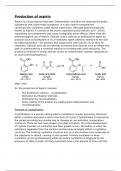Essay
Applied Science Unit 4 Assignment - Learning Aim C
- Institution
- PEARSON (PEARSON)
Production of Aspirin experiment. Whole Assignment: Includes the Experiment Theory, Techniques, Method, Risks, Results, Calculations. Graded at DISTINCTION. References also included.
[Show more]



